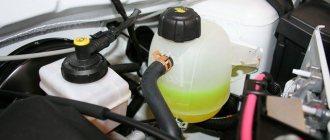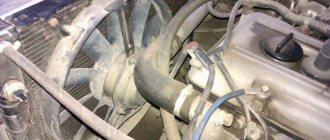Since the operation of an internal combustion engine is associated not only with high mechanical loads, but also with critically high temperatures. For supporting operating temperature power unit, so that it does not fail due to heavy loads, each modification is equipped with a cooling system. There is air and liquid cooling. The engine cooling device is described in detail in another review.
To remove excess heat from the engine, liquid cooling systems have a radiator, and in some car models there is more than one. A fan is installed next to this element. Let's consider the purpose of this part, on what principle it works, how it is designed, and what to do if the mechanism fails en route.
What is a car radiator fan
When the motor is running, it generates a lot of heat. The cylinder block itself of a classic internal combustion engine is designed in such a way that there is a cavity in its walls that is filled with coolant (cooling jacket). The cooling system includes a water pump that operates while the crankshaft rotates. It is connected to the crankshaft via a timing belt (read about it in detail separately ). This mechanism creates circulation of working fluid in the system, due to which it removes heat from the walls of the engine.
Hot antifreeze or antifreeze goes from the engine to the radiator. This element appears to be in the form of a heat exchanger with a large number of thin tubes and cooling fins to increase the contact surface. More details about the design, types and operating principles of radiators are described here .
The radiator is only useful when the car is moving. At this time, a counter flow of cool air blows over the surface of the radiator, resulting in heat exchange. Of course, its effectiveness depends on the ambient temperature, but while driving this flow is still much cooler than the engine coolant.
The principle of cooling operation is at the same time its disadvantage - maximum cooling is only possible when the car is moving (cold air must penetrate the heat exchanger). In urban environments, it is impossible to ensure a constant process due to traffic lights and frequent traffic jams in megacities. The only solution to this problem is to create forced air injection onto the surface of the radiator. The fan performs exactly this function.
When the engine temperature rises, sensors are triggered and the heat exchanger is blown. More precisely, the blades are configured so that the air flow is not supplied against its movement, but is sucked in. Thanks to this, the device is able to increase the radiator airflow even while the car is moving, and when the vehicle is stationary, fresh air enters the engine compartment, rather than using the hot environment near the engine.
In older cars, the fan was rigidly mounted on the crankshaft, so it had a permanent drive. If in summer such a process only benefits the power unit, then in winter excessive cooling of the engine is not beneficial. This feature of the constant operation of the device prompted engineers to develop an analogue that would work only when it was required.
Design and types of fan
Despite its key importance for the cooling system, this mechanism has a fairly simple design. Regardless of modifications, the fan design will consist of three elements:
- The casing, which is the basis of the mechanism, is installed on the radiator itself. The peculiarity of this element is that its design forces the air flow to work in only one direction - not to dissipate upon contact with the heat exchanger, but to pass through it. This casing design allows for more efficient cooling of the radiator;
- Impellers. Each blade is slightly offset from its axis, like any fan, but in such a way that when they rotate, air is sucked through the heat exchanger. Typically this element consists of 4 or more blades;
- Drive.
Depending on the device model, the drive may have a different type. There are three main varieties:
- Mechanical;
- Hydromechanical;
- Electric.
Let's consider each modification separately.
Mechanical drive
The mechanical drive has a simple device. Essentially, this type of fan has a permanent connection. Depending on the characteristics of the engine, it can be connected to the crankshaft through a pulley or through a timing belt. Starting the engine immediately leads to the operation of the impeller, and constant airflow is carried out on the heat exchanger and power unit.
The disadvantage of this type of fan is that it cools the radiator even when it is not needed. For example, when warming up a cold engine, it is important that the unit reaches operating temperature, but in winter this takes longer due to the fluid being too cold. Any malfunction of such a mechanism can seriously affect the operation of the power unit, since part of the torque is also used on the rotational element of the fan.
Also, this arrangement does not allow increasing the speed of rotation of the blades separately from the operation of the motor. For these reasons, this modification is not used in modern cars.
Hydromechanical drive
The hydromechanical drive is a more advanced option, which also operates from a power unit. Only in its design there are several additional elements. This fan uses a special coupling that has a viscous or hydraulic type of actuation. Despite the differences, they have the same principle of operation. In the hydraulic version, the rotation of the impeller depends on the amount of oil entering it.
The viscous coupling ensures that the fan starts and stops by changing the temperature of the silicone filler (its density changes). Since such mechanisms have a complex structure, and the movement of the blades depends on the working fluid, they, like their mechanical counterpart, are also extremely rarely used in modern machines.
Electric drive
Electric drive is the most reliable and at the same time simplest option, which is used in all modern cars. The design of such a fan has an electric motor that drives the impeller. This type of drive has an electric or electromagnetic operating principle. The second modification is more common in trucks. The electromagnetic clutch has the following structure.
The electromagnet is mounted on a hub, which is connected to the armature of the electric motor through a leaf spring, and is capable of rotating. In a quiet state, the electromagnet does not work. But as soon as the coolant reaches approximately 80-85 degrees, the temperature sensor closes the magnet contacts. It creates a magnetic field, thanks to which it attracts the armature of the electric motor. This element enters the coil and the rotation of the blades is activated. But due to the complexity of the design, such a scheme is not used in passenger vehicles.
The use of electronics allows for several operating modes of the device depending on the coolant temperature and crankshaft speed. The peculiarity of such a drive is that it can be turned on regardless of the operation of the internal combustion engine. For example, while the engine is warming up, the fan does not work, and when the coolant reaches its peak temperature, the impeller begins to rotate.
To provide the cooling system with additional air flow, in the latter case it is enough to screw the fan to the appropriate place and connect it to the vehicle’s on-board wiring. Since a similar modification is used in modern vehicles, next we will look at the operating principle of this particular type of fan.
The principle of operation of an internal combustion engine cooling fan
In order for the fan to operate when necessary, it is connected to another system that monitors the working environment. Depending on the modification, its device includes a coolant temperature sensor and a fan relay. This electrical circuit is connected to the fan motor.
This simple system works as follows. A sensor installed at the radiator inlet records the coolant temperature. As soon as it rises to the appropriate value, the device sends an electrical signal to the relay. At this moment, the electromagnetic contact is triggered and the electric motor is turned on. When the temperature in the line drops, the signal from the sensor stops coming and the relay contact opens - the impeller stops rotating.
In more advanced systems, two temperature sensors are installed. One is at the coolant inlet to the radiator, and the other is at the outlet. In this case, the fan is turned on by the control unit itself, which determines this moment by the difference in indicators between these sensors. In addition to this parameter, the microprocessor takes into account the force of pressing the gas pedal (or opening the throttle ), engine speed and readings of other sensors.
Some cars use two fans to improve the performance of the cooling system. The presence of an additional rotating element allows for faster cooling of the heat exchanger due to a greater flow of cool air. Such a system is also controlled by the control unit. In this case, more algorithms work in the microprocessor. Thanks to this, the electronics can not only change the speed of rotation of the blades, but also turn off one of the fans or both.
Also, many cars are equipped with a system in which the fan continues to run for some time after the engine is turned off. This is necessary so that after intense work the hot motor continues to cool for some time. When the engine is turned off, the coolant stops circulating through the system, causing the temperature in the unit to jump sharply and heat exchange does not take place.
This happens extremely rarely, but if the engine was running at maximum temperature and was turned off, the antifreeze may begin to boil and form an air lock. To avoid such a load, in some machines the fan continues to force air onto the cylinder block. This process is called fan free run.
Where is the fan relay located?
4 – electric fan relay; 5 – electric fuel pump relay; 6 – main relay (ignition relay).
Attention: the order of the relays and fuses can be arbitrary, we are guided by the color of the wires. Therefore, we find a relay from which comes a thin pink with a black stripe wire coming from the main relay (pin 85*) (not to be confused with the thin, red with a black stripe wire coming from the controller) and a thick power white with a black stripe wire (pin 87) (white and pink wires we need), this is the fan relay.
Basic radiator fan malfunctions
Despite their simple design and high reliability, cooling system fans also fail, like any other mechanism in the car. There could be many different reasons for this. Let's look at the most common breakdowns and how to fix them.
Most often, drivers encounter the following malfunctions:
- When the engine is running (the car is stationary for a long time), the forced airflow of the heat exchanger does not turn on;
- The fan operates at higher temperatures;
- Air is pumped onto the radiator continuously;
- The blades begin to rotate much earlier than the coolant reaches the required temperature;
- The fan turns on too often, but the engine overheating light does not work. In this case, you should check how dirty the radiator cells are, since air should not just flow onto the surface of the heat exchanger, but pass through it;
- When the radiator airflow is turned on, the flow does not go into the engine compartment, but is supplied in the opposite direction. The reason for this work is the incorrect pinout of the cables (the poles of the electric motor need to be swapped);
- Broken or deformed blade. Before replacing the impeller with a new one, it is necessary to find out the cause of such a breakdown. Sometimes this can happen due to improper installation or installation of a fan that is not intended for a given car model. Otherwise, blade failure is a consequence of natural wear and tear of the material.
Although all of the listed “symptoms” are undesirable for the proper operation of the power unit, the worst thing is if the fan does not turn on at all. This is so because in this case the motor overheating is guaranteed. If you continue to operate it at elevated temperatures, it will quickly fail.
If the fan operates at a temperature exceeding 80-85 degrees (most often this happens after replacing the temperature sensor), you should check whether the coolant temperature sensor is selected correctly. There are modifications for vehicles operated in northern latitudes. In this case, the device is configured to operate at higher temperatures.
A faulty thermostat can also lead to overheating. He talks about this device in detail here . In this case, one side of the cooling system will be excessively hot and the other cold.
The cause of a breakdown of the forced cooling system (not related to the thermostat) may be the failure of one of the coolant temperature sensors (if there are several of them), a breakdown of the motor's electric motor, or loss of contact in the electrical circuit (for example, a broken wire strand, damaged insulation, or oxidized contact). First you need to conduct a visual inspection of the electrical wiring and contacts.
Separately, it is worth mentioning the infrequently encountered problem of a running fan when the engine is cold. This problem is typical for cars equipped with an air conditioning system.
This video explains it in detail:
THE FAN RUNS ON A COLD ENGINE. WHAT TO DO. For all cars with AIR CONDITIONING.
The system can also be tested in the following ways:
- “Ring” the wiring using a tester, multimeter or “tester”;
- The functionality of the electric motor can be checked by connecting it directly to the battery. It is important to observe polarity. If the engine fires, then the problem is in the wires, poor contact or temperature sensor;
- The serviceability of the sensor is checked by shorting its wires. If the fan turns on, then the temperature sensor needs to be replaced.
It is worth considering that for many latest car models, such diagnostics are not available due to the fact that the wiring in them can be well hidden, and getting to the sensor is not always easy. But if there is a problem with the fan or one of the system components, the electronic control unit will immediately generate an error. In most cases, the engine icon will light up on the instrument panel. Some on-board systems allow standard self-diagnosis. Read about how you can call up the corresponding menu on the on-board computer screen here . Otherwise, you need to go for computer diagnostics.
As for early fan operation, this is often a symptom of a faulty coolant temperature sensor. Although every auto mechanic will not be able to subscribe to this conclusion, if the engine reaches operating temperature normally, then you should not worry that the system turns on earlier than necessary. Overheating is much worse for the internal combustion engine. But if it is important for the driver that the car meets environmental standards, then this problem needs to be solved, since in a cold engine the air-fuel mixture does not burn as efficiently. Over time, this will negatively affect the catalyst (read about why it is needed in a car here ).
If the fan motor runs constantly, this is a symptom of a failed sensor, but more often this happens due to “sticking” contacts in the relay (or the coil of the electromagnetic element has burned out, if this modification is used in the machine). If the thermostat breaks, the radiator will often be cold and the fan will not work, even at a critical engine temperature. This happens when the thermostat is stuck in the closed position. If it is blocked in the open state, then the cold internal combustion engine will take too long to reach operating temperature (the coolant immediately circulates in a large circle, and the engine does not heat up).
Electronic drive device
Modern car brands equipped with automatic control systems have begun to install an electric radiator cooling fan motor. The advantage of the drive is its independent operation and ease of configuration.
The engine cooling fan is controlled via coolant temperature modules. Based on data from the sensors, the engine cooling fan control unit adjusts the speed of the impeller, changing the rotation speed and operating period.
Power to the fan motor is supplied through the vehicle's electronic devices (battery, generator).
Methods for controlling the engine cooling fan:
- thermal switch;
- Control block.
Technical indicators.
| Name | Engine | ||
| 88 kW/5500 rpm | 104 kW/6000 rpm | 122 kW/6500 rpm | |
| Cooling system type | Water with electric drive | ||
| Pump type | Belt driven centrifugal | ||
| Thermostat | |||
| Operation temperature, C° | 80,0 — 85,0 | ||
| Maximum opening, С° | 97 | ||
| Stroke at maximum opening, mm | From 8 | ||
| Valve opening pressure in the lid, kPa | 112,9 — 142,5 | ||
The thermal switch was used in the early stages of automobile production. Based on the readings from the temperature sensor in the radiator, the mechanism determines whether the engine cooling fan will turn on or off. In units with a thermal switch, the engine cooling fan operates within a narrow temperature range. The cooling fan turns on when the unit warms up to 85 C°, and turns off when it cools down to 70 C°.
What to do if the fan breaks down while traveling?
Often a cooling fan breakdown occurs somewhere along the road. If it stops working, then in city mode the antifreeze will definitely boil. Here are a couple of tricks that can help in this case:
- Firstly, if the breakdown occurred on the highway, then in high-speed mode it is easier to ensure airflow to the heat exchanger. To do this, it is enough to move at a speed of at least 60 km/h. In this case, cool air will flow into the radiator in large quantities. In principle, in this mode the fan rarely turns on, so the system will operate normally.
- Secondly, the heating system of the cabin uses the thermal energy of the cooling system, so in emergency mode you can turn on the heating to use the heater radiator. Of course, in the summer, driving with the interior heating on is still a pleasure, but the engine will not fail.
- Thirdly, you can move in short bursts. Before the coolant temperature arrow reaches its maximum value, we stop, turn off the engine, open the hood and wait until it cools down a little. Under no circumstances should you water the unit with cold water during this procedure, so as not to cause a crack in the cylinder block or head. Of course, in this mode the journey will be significantly longer, but the car will be intact.
However, before performing such procedures, you should check why the fan does not turn on. If the problem is in the wiring or sensor, then to save time you can connect the electric motor directly to the battery. Don't worry about the battery running out. If the generator is working, then while the internal combustion engine is running, the on-board system is powered from it. Read more about the operation of the generator separately .
Although in many cars you can replace the air blower yourself, if the car is still under warranty, it is better to use the services of a service center.
Fans with thermal switch
Similar mechanisms were installed on cars before the invention of the electronic unit. For example, a VAZ cooling fan is also equipped with a thermal switch. This device is responsible for turning on/off the system's electric motor.
The principle of operation of this type of cooling fans is as follows: the signal is sent from a temperature sensor, which is installed in the cylinder block housing on a special scale located in the vehicle interior. This indicator and the response of the thermal switch to changes in the temperature of the liquid in the radiator affect the procedure for turning the engine on and off.
If the temperature of the cooler is increased to the maximum, the contacts inside the thermal switch will be closed and connected to the system power circuit. Then current will be supplied to the electric motor, which will cause the fan impeller to rotate. The contacts will open if the temperature drops to the extreme minimum, which guarantees that the device will turn off.











